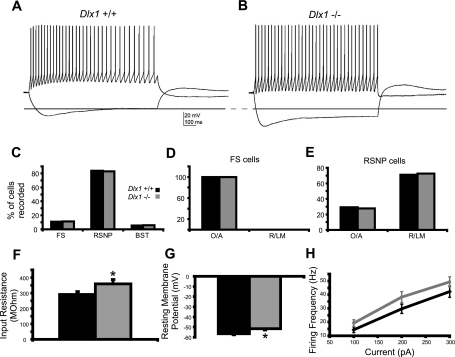Fig. 3.
Young Dlx1−/− interneurons exhibit immature membrane properties compared with young WT interneurons. A: sample current-clamp recording from a WT RSNP interneuron. B: sample trace from a Dlx1−/− RSNP interneuron. Note increased input resistance (dashed line). C: overall proportions of interneuron subtypes encountered were comparable between WT and mutant mice. D: in both WT and Dlx1−/− mice, all FS cells were found in stratum oriens/alveus (O/A). E: in both WT and Dlx1−/− mice, most RSNP cells were recorded in stratum radiatum and stratum lacunosum-moleculare (R/LM). F: Input resistance is significantly increased in interneurons recorded form Dlx1 knockout mice (P < 0.05, Student's t-test). G: resting membrane potential is significantly depolarized in Dlx1−/− interneurons (P < 0.05, Student's t-test). H: plot of firing frequency vs. current showing that interneurons from Dlx1−/− mice fire at modestly higher rates in response to a given step size, compared with WT interneurons (P < 0.05, one-way ANOVA). Black bars, WT; gray bars, Dlx1−/−.

